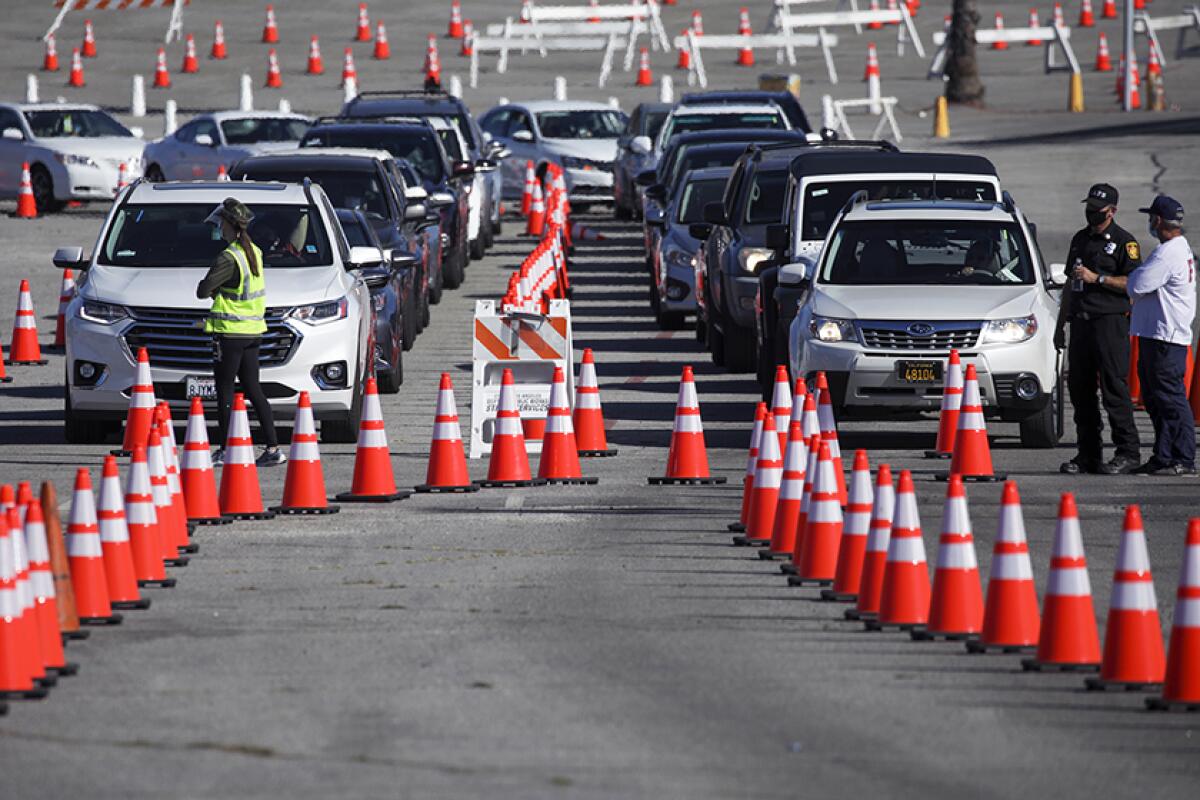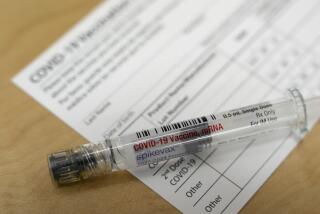More problems slow COVID-19 vaccine distribution in Los Angeles

- Share via
Los Angeles continued to struggle with COVID-19 vaccine distribution due to a variety of factors Friday as officials pushed forward with efforts to get underserved Black and Latino communities inoculated.
The city postponed more vaccination appointments scheduled for Saturday as vaccine shipments remain stuck in transit by winter weather that has hammered much of the country.
It was not immediately clear how many appointments were affected, but the delays will occur at the large-scale vaccination sites run by the city at Hansen Dam Recreation Area, San Fernando Park, Lincoln Park, Pierce College, Crenshaw Christian Center and Dodger Stadium.
Officials already pushed back 12,500 appointments scheduled Friday because of supply disruptions. City-run mobile vaccination clinics will continue to operate as scheduled.
Officials said Thursday afternoon that the weather delays had yet to interrupt operations at vaccine sites run by L.A. County, which include the Pomona Fairplex, the Forum in Inglewood, Cal State Northridge, the county Office of Education, Six Flags Magic Mountain, Balboa Sports Complex and El Sereno Recreation Center.
The new postponements, which L.A. Mayor Eric Garcetti announced Friday, mark the latest fallout from the winter weather that has battered much of the country, with days of freezing rain, ice and snow that have knocked out power, grounded flights and created hazardous travel conditions.
The inclement weather has tied up two L.A.-bound shipments of the Moderna vaccine, totaling some 63,000 doses, that were supposed to be available for appointments this week and next, according to city officials.
The main manufacturing facilities for the nation’s two COVID-19 vaccines — made by Moderna and Pfizer-BioNTech — are in Massachusetts and Michigan.
The state was anticipating stepped-up vaccine deliveries in the coming weeks, but that was before the winter storms struck. And those distributions still would have brought far fewer doses than what is needed to quickly work through the queue of people eligible to receive vaccines.
California — along with the rest of the country — has been contending with a scarcity of vaccines, with officials saying they have the capacity, but not the supply, to inoculate significantly more people.
A consistent challenge is that both available COVID-19 vaccines require two doses, administered three or four weeks apart.
Lately, the need to provide second shots has spurred officials throughout the state to greatly limit access to first doses.
Meanwhile, officials are ramping up efforts to get more vaccine to underserved communities.
“We’re seeing still disproportionately low vaccination rates among many of our Black and Latino populations and communities, a reflection not only of historic distrust and community trauma, but also the structural barriers that stand between too many Angelenos and their access to vaccines,” Garcetti said Thursday. “We need to tear those barriers down.”
His comments come after data showed that Black, Latino and Native American residents 65 and over were receiving COVID-19 vaccinations at a lower rate than their white, Asian American and Pacific Islander counterparts.
In L.A. County, Latinos are seeing 40 COVID-19 deaths per 100,000 residents a day and Black residents are seeing 20 deaths, compared with 14 deaths per 100,000 white residents a day.
Neighborhoods will be prioritized for mobile vaccination clinics using medical vulnerability indicators developed by UCLA researchers, including the incidence of preexisting health conditions, barriers to accessing service, environmental risks and social vulnerability.
Mobile vaccination services this week expanded to South Park, Green Meadows and Boyle Heights; in coming days, that will widen to include Chinatown, Vermont Square and Pico-Union, the city said in a news release. By the end of March, the city hopes to have additional sites in East L.A., South L.A., Northeast L.A. and the East San Fernando Valley.
More to Read
Sign up for Essential California
The most important California stories and recommendations in your inbox every morning.
You may occasionally receive promotional content from the Los Angeles Times.















